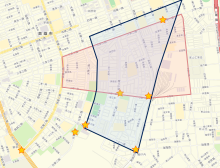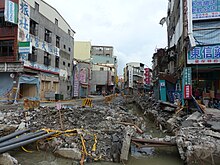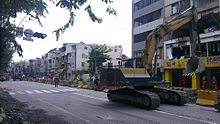Gas explosions in Kaohsiung in 2014
The gas explosions in Kaohsiung in 2014 consisted of a series of violent detonations in the Taiwanese port city of Kaohsiung on the night of July 31 to August 1, 2014. A similar accident had already occurred in 1997. The detonations occurred in the districts of Qianzhen ( 前 鎮 ) and Lingya ( 苓雅 ). 32 people were killed and 321 injured in the gas explosions.
Expires from July 31, 2014 to August 1, 2014
At 8:46 p.m., a resident noticed a smell of gas and intermittent clouds of white gas leaking from a gully. Concerned, other residents then notified the fire department and reported a gas leak. A little later the fire brigade appeared on site and splashed water on the floor to cool it. At around 10:20 p.m., the first explosion occurred on Ruilong Road ( 瑞隆 路 ), about one kilometer from the first location. The manhole covers were thrown into the air by the detonation. The Kaohsiungs Environmental Protection Agency sent experts to conduct gas analyzes at 10:22 p.m. Gas samples were taken for analysis with a mobile FTIR spectrometer . Even before the analysis, the second explosion occurred on Gangshan Road ( 岡山 路 ), which also destroyed the analysis car and the spectrometer. Again the manhole covers were catapulted meters high into the air. Only hours later, around 6:30 a.m., could the escaping gas be identified as propene after a second FTIR spectrometer was available.
The third explosion occurred at 11 p.m. at the intersection of Sanduo Road ( 三多 一路 ) and Wuqing Road ( 武 慶 三 路 ). The third detonation was so strong that most of the soil under the streets and adjacent houses sagged. Several firefighters were killed in the fourth explosion at the intersection of Ersheng Road ( 二 聖 路 ) and Kaixuan Road ( 凱旋路 ) at 11:25 p.m. The city government had meanwhile evacuated the affected district. In the fifth detonation at 11:57 p.m. almost the entire Ersheng Road ( 二 聖 路 ) was destroyed. Road users were killed and injured. Of all the explosions, the fifth was by far the largest and most violent. The explosion propagated through the sewers, north along Kaixuan 2nd Road and south along Kaixuan 3rd Road. At the end of the former, the explosion wave continued along Sanduo 1st Road to the intersection with Wuqing 2nd Road. A total of 4.5 kilometers of streets were torn up.
Consequences of the explosions
On August 1, 2014, the streets were in ruins and parts of the streets had sunk. The pressure wave had carved a path of destruction (approx. 6 kilometers long) and tore the affected streets in two. Scooters, cars and even trucks had been thrown through the area by the massive detonations and some cars had even been catapulted onto the roofs of houses. The explosions resulted in gas shutdowns and power outages. Taiwan's then Minister of Economy and Rescue Director Jiang Yi-huah (江宜樺) stated that there had been at least five large explosions in the neighborhoods. 1,100 residents were asked to leave their homes and placed in emergency shelters. The rescue work was difficult because extremely flammable gas could have accumulated everywhere. The Taiwan government sent soldiers from across the country to Kaohsiung to assist with the rescue. The rescue workers dug their way through piles of rubble and searched for survivors with sonar equipment . Special units clad in protective suits ensured that no more explosive gas escaped.
root cause
As the incident progressed, it became clear that the cause was a leak in a liquefied gas pipeline. The leaky pipeline was a high-pressure pipeline that was built specifically for the transport of liquid propene (propylene) between 1986 and 1993. It connected the LCY Chemical Corporation Tashe ( 李長榮 化學 工業 ) with the China General Terminal & Distribution Corporation (CGTDC, 華 運 倉儲 ) located in the port area over a distance of 27 kilometers . At the time of laying, care had been taken to ensure that the pipeline did not run through residential areas. In the following 25 years of operation, however, numerous residential and commercial buildings were built near the pipeline. Post-explosion investigations revealed that at 8:43 p.m. there was a sudden pressure drop from 4.2 MPa to 1.37 MPa at the pressure sensor in the CPC pipeline connected to the LCY pipeline. CGTDC and the LCY Tashe systems had no pressure sensors installed on their side of the pipeline, only pressure gauges and flow meters . At the same time, the operations manager of the LCY Tashe plant determined a flow rate of zero. In contrast, an abnormally high flow rate was found with CGTDC. The pumping process was temporarily interrupted and the pressure in the pipeline was measured, which remained at 1.3 ~ 1.35 MPa. Eventually the pumping process was resumed. At around 11:23 p.m., a CGTDC foreman noticed a gas smell on his way to work. Suspecting that it might be a pipeline leak, he rushed to work, where he arrived 10 minutes later and arranged for the pumps to be switched off. A few minutes later, the main explosion occurred at 11:57 p.m.
According to later model calculations, about 9 tons of propene had escaped. After investigating the explosion, the Kaohsiung City Government found more details. LCY stated that the company CGTD (China General Terminal and Distribution Corporation, 華 運 倉儲) was responsible for the gas transport. However, no abnormal pressure was found at CGTD, and so the explosions occurred. According to LCY, the company CGTDC was also responsible for the detection of pressure losses and both companies, LCY and CGYDC, should be held responsible for the explosion.
Reactions
When President Ma Ying-jeou (馬英九) heard about the explosion in Kaohsiung, he immediately coordinated the rescue operation. In addition, the national flag was hoisted at half-mast for three days to commemorate the dead. Economy Minister Chang Chia-juch (張家 祝) resigned from his post on August 10, 2014, although no personal guilt for the accident was proven.
Many governments expressed their condolences for the tragedy in Kaohsiung. B. the governments of China, Hong Kong, Macau, France, Japan, Singapore and Great Britain, as well as the Commissioner of the European Union.
reconstruction
So that the victims could quickly find their way back to normal life, the city government quickly began the clean-up work. A rough estimate of the cost of damaged roads and the sewer system was around NT $ 1.9 billion (around EUR 47 million at the then rate). In the days after the explosion, the clean-up was hampered by heavy rain and flooded roads. On November 20, 2014, the streets were already passable again, some of the houses were renovated and the restoration work was completed.
On July 18, 2015, the Kaohsiung City Council reached an agreement with the two responsible companies, LCY Chemical Corp. (李長榮 化工) and China General Terminal & Distribution Corporation (華 運 倉儲, CGTD) on compensation payments to the relatives of the people killed. Each family of a deceased should receive NT $ 12 million (about € 356,000) in compensation. By then, those affected had already received NT $ 9.8 million each from private donations from the public and industry.
Web links
- Recordings of the explosions and destruction , YouTube videos
- The 2014 Kaohsiung gas explosion - one year later (Chinese)
- The cause of the 2014 Kaohsiung gas explosion (Chinese)
- 25 deaths from gas explosions in Taiwan . Swiss radio and television , August 1, 2014, accessed June 10, 2017.
- Lee, Yanling: Massive Gas Explosion in Kaohsiung (English)
Individual evidence
- ↑ a b Hui-Ning Yang, Jen-How Chen, Home-Jo Chiu, Ting-Jia Kao, Hsiao-Yun Tsai, Jenq-Renn Chen: Kaohsiung Vapor Explosion - A Detailed Analysis of the Tragedy in the Harbor City . In: Chemical Engineering Transactions . tape 48 , 2016, ISBN 978-88-95608-39-6 , ISSN 2283-9216 , pp. 721-726 , doi : 10.3303 / CET1648121 (English).
- ↑ Taiwan Gas explosion kills 25 and injures over 260. (No longer available online.) The Telegraph , August 1, 2014, formerly original ; accessed on June 5, 2017 . ( Page no longer available , search in web archives ) Info: The link was automatically marked as defective. Please check the link according to the instructions and then remove this notice.
- ↑ 台灣 電力 公司 ( Taiwan Power Company ): 高雄 氣 爆 事件 探索. In: SlideShare . August 4, 2014, Retrieved June 4, 2017 (Chinese).
- ↑ Woody Duh named new head MOEA. Taipei Times, August 11, 2016, accessed September 20, 2017 .
- ↑ according to currency converter: Taiwanese Dollar - Euro (TWD in EUR) from finanzen.net, accessed June 10, 2017
- ^ Alan Fong: Kaohsiung agrees to gas blast settlement. The China Post, July 18, 2015, accessed September 20, 2017 .




